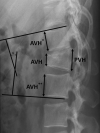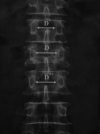Analysis of factors associated with the failure of treatment in thoracolumbar burst fractures treated with short-segment posterior spinal fixation
- PMID: 37715197
- PMCID: PMC10503025
- DOI: 10.1186/s13018-023-04190-w
Analysis of factors associated with the failure of treatment in thoracolumbar burst fractures treated with short-segment posterior spinal fixation
Abstract
Background: The treatment of thoracolumbar burst fractures continues to pose challenges. Although short-segment posterior spinal fixation (SSPSF) has shown satisfactory clinical outcomes, it is accompanied by a relatively high rate of treatment failure. This study aimed to assess factors associated with treatment failure in thoracolumbar burst fractures treated with SSPSF.
Methods: The clinical data of 241 consecutive patients with a traumatic thoracolumbar burst fracture who underwent SSPSF at our center between Apr 2016 and Apr 2021 were retrospectively reviewed. Patients were divided into two groups (failure of the treatment group and non-failure of the treatment group). We compared potential risk factors for the failure of treatment including age, gender, body mass index, smoking, diabetes, vertebral body compression rate, use of crosslinks, percentage of anterior height compression, presence of index level instrumentation, Cobb angle, interpedicular distance (IPD), canal compromise, Load Sharing Classification (LSC) score, use of posterolateral fusion, and pain intensity between the two groups.
Results: A sum of 137 (56.8%) males and 104 (43.2%) females were enrolled where the mean age and follow-up of the participants were 48.34 ± 10.23 years and 18.67 ± 5.23 months, respectively. Treatment failure was observed in 34 cases (14.1%). The results of the binary logistic regression analysis revealed that the lack of index level instrumentation (OR 2.21; 95% CI 1.78-3.04; P = 0.014), LSC score (odds ratio [OR] 2.64; 95% confidence interval [95% CI], 1.34-3.77; P = 0.007), and IPD (OR 1.77; 95% CI 1.51-2.67; P = 0.023) were independently associated with a higher rate of failure of treatment.
Conclusions: The findings of this study revealed that increased rates of treatment failure in thoracolumbar burst fractures treated with SSPSF were associated with factors such as the absence of index level instrumentation, higher LSC scores, and larger IPD. These findings could be helpful in the proper management of patients with unstable thoracolumbar burst fractures.
Keywords: Failure of treatment; Interpedicular distance; Load sharing classification; Short-segment posterior spinal fixation; Thoracolumbar burst fractures.
© 2023. BioMed Central Ltd., part of Springer Nature.
Conflict of interest statement
The authors declare that they have no competing interests.
Figures


Similar articles
-
The efficacy of machine learning models in forecasting treatment failure in thoracolumbar burst fractures treated with short-segment posterior spinal fixation.J Orthop Surg Res. 2024 Apr 1;19(1):211. doi: 10.1186/s13018-024-04690-3. J Orthop Surg Res. 2024. PMID: 38561767 Free PMC article.
-
Vertebral body spread in thoracolumbar burst fractures can predict posterior construct failure.Spine J. 2018 Jun;18(6):1005-1013. doi: 10.1016/j.spinee.2017.10.064. Epub 2017 Oct 23. Spine J. 2018. PMID: 29074467
-
Viability and long-term survival of short-segment posterior fixation in thoracolumbar burst fractures.Spine J. 2015 Aug 1;15(8):1796-803. doi: 10.1016/j.spinee.2014.03.012. Epub 2014 Mar 15. Spine J. 2015. PMID: 24642054
-
Successful short-segment instrumentation and fusion for thoracolumbar spine fractures: a consecutive 41/2-year series.Spine (Phila Pa 1976). 2000 May 1;25(9):1157-70. doi: 10.1097/00007632-200005010-00018. Spine (Phila Pa 1976). 2000. PMID: 10788862 Review.
-
Anterior, Posterior and Anterior-Posterior Approaches for the Treatment of Thoracolumbar Burst Fractures: A Network Meta-Analysis of Randomized Controlled Trials.J Invest Surg. 2024 Dec;37(1):2301794. doi: 10.1080/08941939.2024.2301794. Epub 2024 Jan 10. J Invest Surg. 2024. PMID: 38199978 Review.
Cited by
-
Risk Factors of Correction Loss After Percutaneous Reduction and Fixation for Thoracolumbar Burst Fracture: A One-Year Follow-Up Study.Cureus. 2025 May 28;17(5):e84961. doi: 10.7759/cureus.84961. eCollection 2025 May. Cureus. 2025. PMID: 40585665 Free PMC article.
-
Predictors of failure in posterior short segment instrumentation for thoracolumbar burst fractures: a systematic review and meta-analysis.J Orthop Surg Res. 2025 Aug 7;20(1):736. doi: 10.1186/s13018-025-06149-5. J Orthop Surg Res. 2025. PMID: 40775716 Free PMC article.
-
Lateral lumbar and thoracic interbody fusion (LLIF) for thoracolumbar spine trauma (Trauma LLIF): A single-center, retrospective observational cohort study.N Am Spine Soc J. 2024 Jul 27;19:100534. doi: 10.1016/j.xnsj.2024.100534. eCollection 2024 Sep. N Am Spine Soc J. 2024. PMID: 39257670 Free PMC article.
-
Risk factors for failure in short segment pedicle instrumentation in thoracolumbar fractures.Brain Spine. 2025 Apr 28;5:104266. doi: 10.1016/j.bas.2025.104266. eCollection 2025. Brain Spine. 2025. PMID: 40417011 Free PMC article.
-
The clinical and radiological outcomes of a transfacet pedicle-sparing approach for directly addressing the compression of unstable thoracolumbar burst fractures with retropulsion.BMC Surg. 2025 Apr 10;25(1):149. doi: 10.1186/s12893-025-02883-z. BMC Surg. 2025. PMID: 40211214 Free PMC article.
References
-
- Aligizakis A, Katonis P, Stergiopoulos K, Galanakis I, Karabekios S, Hadjipavlou A. Functional outcome of burst fractures of the thoracolumbar spine managed non-operatively, with early ambulation, evaluated using the load sharing classification. Acta Orthop Belg. 2002;68(3):279–287. - PubMed
-
- Vaccaro AR, Wilson JR, Fisher CG. The three-column spine and its significance in the classification of acute thoracolumbar spine injuries. In: 50 Landmark Papers Every Spine Surgeon Should Know. CRC Press; 2018. p. 65–8.
MeSH terms
LinkOut - more resources
Full Text Sources
Miscellaneous

